-

人教版新目标初中英语八年级上册How was your school trip教案2篇
“Go for it!” is based on “Task-Based Language Teaching”. It adheres to “The authenticity principle”, “The form-function principle”, “The task dependency principle” and “The principle of learning by doing”. These principles all accord with the demands of curriculum focus.In and of Grade Seven (II), “Go for it!”, students have learned “The Simple Past Tense”. And it appears again in of Grade Eight (I). teaches students more about how to talk about events in the past. In addition, it gives affirmative and negative statements in the past tense, such as the sentence patterns “Did you see …?” “Were there …?” “Did you go …?” As the first part of Unit 8, Section A opens with a picture presenting the last school trip in the aquarium and continues with several step-by-step practice activities, which are all good for students to master “The Simple Past Tense”. Doing well in Section A will help students integrate the new target language with that in Section B. Thus, they can describe the events in the past freely and foster their own ability of reflecting and practicing. II. Teaching ObjectivesTeaching objective is the beginning and aim of teaching activities. According to the overall goal of the English elementary course--- improve students' synthetic ability of language application, which should be based on the development of students’ “Language knowledge”, “Language skills”, “Character building”, “Learning strategies” and “Cross-cultural awareness”. The teaching objectives are described as follows(I). Knowledge objectivesi. Master the simple past tense of regular and irregular verbsii. Recite the new words and expressions about the last school trip in the aquarium, including their pronunciation and intonation

人教版新目标初中英语九年级上册I like music that I can dance to教案
教学目标: 1. Express preferences2. Talk about one’s likes and dislikes and the reasons3. Learn to express one’s opinions 4. Learn to write a reply 语言功能: 1) Talk about one’s preferences, using t he relative clause2) Talk about people’s likes and dislikes and the reasons3) Talk about opinions语言结构: Relative clauses with that and who语言目标:What kind of music do you like?I like music that I can sing along with.I love singers who write their own music.We prefer music that has great lyric.重点词汇及短语:heart, photography, interest, class, whatever, miss, okay, expect, sweet, taste, itself, laboratory, cancer, increase, biscuit, main, care, prefer… to…, remind somebody of …, dance to, sing along with, be sure to, interest somebody, make somebody adj., to be honest, suit somebody, on display, catch up教学重难点:What do other people think of the different kinds of things? How to express one’s opinions? 学习方式:讨论,合作学习情感目标:通过本单元的学习,能提高学生的艺术鉴赏能力和审美情趣,并引导学生养成健康的饮食习惯。课时安排5课时第一课时:Section A: 1a-2c第二课时:Section A : 3a-4第三课时:Section B:1-2c, Self check2第四课时:Section B: 3a-4, Self check1第五课时:Self check ReadingI like music that I can dance to.

人教版新目标初中英语九年级上册I used to be afraid of the dark教案
内容提示1.本单元主要内容是学会used to结构。Used to +动词原形表示过去经常、以前常常,只用于过去式中,用来表示现在已不存在的习惯或状态。例如:They used to play football together.他们过去常在一起蹋足球。(现在不在一起踢了)2.used to的疑问形式和否定形式为Did you use to…?和I didn’t use to… 也可以用Used you to…?和I used not to…但现在多使用前者。例如:Did you used to swim in the river? 你过去常在河里游泳吗?I didn’t use to play the piano. 我以前并不经常弹钢琴。教学目标一、学习目标(Language Goal) 1.学会陈述自己过去常做的事情。2.学会陈述自己过去的爱好等。3.能够表达自己现在和过去在外表、性格、娱乐等方面的变化。4.能够表达朋友、家人等现在和过去的变化。二、语言结构(Language Structures) 1.I used to be short when I was young. 我年轻时个子很矮。 2. —Did you use to have straight hair? 你过去是直发吗?—Yes, I did. 是的。 3. —Did you use to play the piano? 你过去弹钢琴吗?—No, I didn’t. 不,我不弹。 4.I used to be afraid of dark. 我过去害怕黑暗。 5.I’m terrified of the snakes. 我害怕蛇。

人教版新目标初中英语九年级下册By the time I got outside, the bus had already left教案
Ⅰ. Teaching Aims and Demands1. Knowledge Objects(1) Key Vocabularyoversleep(2) Target LanguageWhat happened?I overslept. And by the time I got up, my brother had already gotten in the shower.2. Ability Objects(1) Teach the students to use the new words.(2) Train the students to narrate past events with the Past Perfect Tense.(3) Train the students' listening and speaking skills with the target language.3. Moral ObjectIt’s a good habit to go to bed early in the evening and get up early in the morning. So you’ll never be in a hurry in the morning.Ⅱ. Teaching Key Points1. Key Vocabularyoversleep2. Target LanguageNarrate past events with the Past Perfect TenseⅢ. Teaching Difficult Points1. Train the students to narrate past events with the Past Perfect Tense.2. Train the students to understand the target language in spoken conversation.Ⅳ. Teaching Methods1. Thinking of examples from the students' real lives.2. Making sentences by looking at the pictures.Ⅴ. Teaching AidA tape recorderⅥ. Teaching ProceduresStep I Revision1. Revise the language points in Unit 8.Ask some questions like this: What volunteer work would you like to do?Help the students to answer, I’d like to…/I love to…/I hope to2. Practice the dialogue in Activity 3c on page 62 again. Get students to role play the similar dialogues with the following.

人教版新目标初中英语九年级上册It must belong to Carla教案
一、Section A该部分有4个模块。第一模块围绕Whose volleyball is this? 这一话题展开思维( 1a)、听力(1b)、口语( 1c)训练;第二模块围绕上一模块中的话题进行听力( 2a-2b)、口语训练( 2c);第三模块继续围绕前两个模块中的“making inferences”展开训练。训练形式为阅读排序( 3a)和两人问答(3b);第四模块仍就上一话题展开讨论。二、Section B该部分有4个模块。第一模块要求根据图画和所提供的单词写出合理的句子;第二模块在听力( 2a-2b)和分角色口语训练( 2c)的基础上,继续进行“推测”训练; 第三模块围绕“Strange events in Bell Tower neighborhood”这一话题展开阅读( 3a)和写作(3b -3c)训练;第四模块以dream为话题展开小组活动。三、Self Check该部分有3个模块。第一模块以填空形式对所学词汇进行训练;第二模块就8个谚语展开阅读和讨论。

人教版新目标初中英语九年级下册Rainy days make me sad教案
1. 教材分析本单元以how do things affect you?为话题, 从颜色、天气、音乐、广告、产品等方面谈论了外界事物如何影响人的心情。要求学生掌握表达某物或某事给人带来的感觉、看法或影响等。共设计了四个部分的内容:Section A 该部分有4个模块:第一模块围绕Which restaurant would you like to go to?这一话题展开思维(1a)、听力(1b)、口语(1c)训练;第二模块围绕How does music affect you? 进行听力(2a-2b)、口语训练(2c);第三模块继续围绕how do colors in the restaurant affect you这一话题展开训练,训练形式为阅读和问题体验(3a)和小组活动(3b);第四模块仍就How do things affect you这一话题以调查的形式展开讨论。Section B该部分有4个模块:第一模块围绕产品广告对人们的影响这一话题以“配对”(1a)与“列举”(1b)两种形式展开训练;第二模块继续围绕How do things affect you? 进行听力(2a-2b)、口语对话训练(2c);第三模块围绕“Advertising”这一话题展开阅读(3a-3b)和写作(3c)训练;第四模块围绕How posters affect you这一话题以口语训练形式展开小组活动。

人教版新目标初中英语九年级下册Could you please tell me where the restrooms are教案
Step Ⅰ RevisionCheck homework. Ask a few students to read the article in 3a.Then ask a few students to read their guides.Step Ⅱ Part 1Look at the words in the box. Ask a student to read them. Make sure the students understand the meaning of the words. You are to fill in the blanks with the words. In some cases, students may need to use another form of the word, for example adjusting for tense or subject/ verb agreement.Ask students to fill in the blanks on their own.Check the answers. Step ⅢPart 2Go through the instructions with the class.Look at the example with the students.Ask students what the answer would be.Ask a student to read the question and answer it.Excuse me, could you tell me where the bank is, please?The bank is across the street from the shopping malt.Get students to complete the work in pairs.Check the answers. Ask a few students to read their questions.Step Ⅳ Just for Fun!Ask all the students to read the conversation. Ask: What is funny about this cartoon? Help students to explain. A Martian is a person from the planet Mars.There is no such thing as Martian food on Earth, and the clerk looks silly because he is trying to think of where there is a Martian restaurant.Invite some pairs of students to present this conversation to the rest of the class.Step Ⅴ Summary and HomeworkIn this class, we’ve done much writing practice using the key vocabulary words and the target language presented in this unit. After class, please finish the questions in 2 in your exercise books. Then finish the exercises on pages 47~48 of the workbook as well.The Seventh Period Ⅰ Teaching Aims and Demands1. Knowledge Objects(1) Key Vocabularyimage, adventure, jealousy, hero, crime, journey, brave, no longer, show interest in, take it easy, become interested in, plain looks(2)Text:Grown-ups like cartoons, too.2. Ability Objects(1) Fast-reading to get a general idea of the text.(2) Careful-reading to get the detailed information in the text.

人教版新目标初中英语九年级下册I’ll help clean up the city parks教案
Talk about offering help (P60)I’ll help clean up the city parks.A: I’d like to work ...B: You could help ...Talk about ways to tell people about the Clean-Up Day (P61)We need to ...We can’t ...I’ll ...Talk about the work the volunteers do (P62)These three students all volunteer their time to help other people.Somebody loves to ... / helps ... / plans to ... / wants to ...A: What do you like doing?B: I like ... A: What kind of volunteer work do you think I could do?B: You could ...1. 重点词汇advertisement, fix, repair, pleasure, blind, deaf, shut, carry, specially, fetch2. 认读词汇hunger, homeless, cheer, clean-up, sign, establish, major, commitment, elementary, veterinarian, coach, similar, call-in, strategy, disabled, organization, unable, support, appreciate, donation, part of speech, pronoun, adverb, preposition, conjunction, donate, Jimmy, Sally3. 词组clean up, cheer up, give out, put off, set up, think up, take after, fix up, give away, put up, hand out, work out, at once
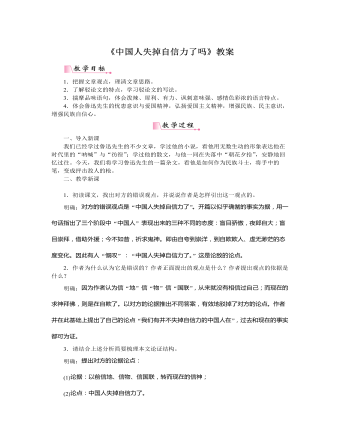
部编版语文九年级上册《中国人失掉自信力了吗》教案
一、导入新课我们已经学过鲁迅先生的不少文章,学过他的小说,看他用无数生动的形象表达他在时代里的“呐喊”与“彷徨”;学过他的散文,与他一同在失落中“朝花夕拾”,安静地回忆过往。今天,我们将学习鲁迅先生的一篇杂文,看他是如何作为民族斗士,将手中的笔,变成抨击敌人的枪。二、教学新课目标导学一:学习驳论,理清思路1.初读课文,找出对方的错误观点,并说说作者是怎样引出这一观点的。明确:对方的错误观点是“中国人失掉自信力了”。开篇以似乎确凿的事实为据,用一句话指出了三个阶段中“中国人”表现出来的三种不同的态度:盲目骄傲,夜郎自大;盲目崇拜,借助外援;今不如昔,祈求鬼神。即由自夸到崇洋,到自欺欺人、虚无渺茫的态度变化。因此有人“慨叹”:“中国人失掉自信力了。”这是论敌的论点。
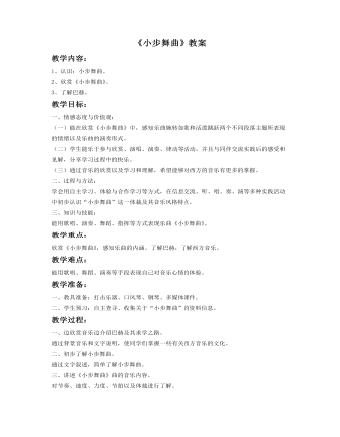
《小步舞曲教案》教案
教学过程:一、边欣赏音乐边介绍巴赫及其求学之路。通过背景音乐和文字说明,使同学们掌握一些有关西方音乐的文化。二、初步了解小步舞曲。通过文字叙述,简单了解小步舞曲。三、讲述《小步舞曲》曲的音乐内容。对节奏、速度、力度、节拍以及体裁进行了解。四、结合谱例分段学习《小步舞曲》。1、学习乐曲A’段。说明:依据乐曲创作背景,合理创设“舞会”情景,从而有效激发学生学习兴趣,用舞蹈表现手段演绎此乐段,发展了学生的舞蹈表演能力,享受到美的愉悦。2、学习乐曲B段。说明:利用形象、直观的图式辅助以及一系列贴近学生思维逻辑的问答讨论,激发学生的思考,帮助学生准确把握乐段情绪,并能用指挥、伴奏等方式表现该乐段。3、完整欣赏《小步舞曲》。说明:学生在完整欣赏乐曲时能够巩固乐曲主题的记忆,并且听辨、感受乐曲两个不同主题情绪,培养学生独立的音乐感受和见解。五、视频欣赏。说明:通过视屏欣赏,使同学们以一个更直观的郊区去理解和学习作品,并使同学对作品有更深刻的记忆。引起学生共鸣,领悟音乐的美感,愉悦身心,获取乐趣,从而激起学习的情趣。
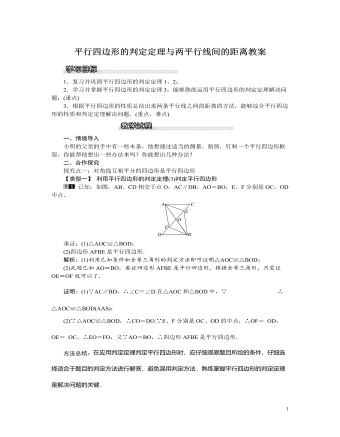
北师大初中八年级数学下册平行四边形的判定定理3与两平行线间的距离教案
(2)∵点G是BC的中点,BC=12,∴BG=CG=12BC=6.∵四边形AGCD是平行四边形,DC=10,AG=DC=10,在Rt△ABG中,根据勾股定理得AB=8,∴四边形AGCD的面积为6×8=48.方法总结:本题考查了平行四边形的判定和性质,勾股定理,平行四边形的面积,掌握定理是解题的关键.三、板书设计1.平行四边形的判定定理3:对角线互相平分的四边形是平行四边形;2.平行线的距离;如果两条直线互相平行,则其中一条直线上任意一点到另一条直线的距离都相等,这个距离称为平行线之间的距离.3.平行四边形判定和性质的综合.本节课的教学主要通过分组讨论、操作探究以及合作交流等方式来进行,在探究两条平行线间的距离时,要让学生进行合作交流.在解决有关平行四边形的问题时,要根据其判定和性质综合考虑,培养学生的逻辑思维能力.
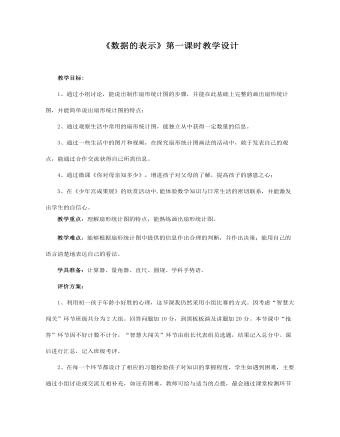
数据的收集与整理 3 数据的表示教案教学设计
创设情境,导入新课:你对母亲知多少师问1:我们5月份刚过了一个重要的节日,你知道是什么吗?----母亲节。师问2:那你知道妈妈的生日吗?(举手示意),每个妈妈都知道自己孩子的生日,请不知道的同学回家了解一下,多关心一下自己的父母。师问3:那你知道妈妈最爱吃的菜吗?你可以选择知道、不知道或者是没有爱吃的(拖动白板上相对应的表情符号)。请大家用不同的手势表示出来。我找3名同学统计各组的数据,写在黑板上(随机找3名学生数人数)。下面我来随机采访一下:你妈妈最喜欢吃的菜是什么?(教师随机采访,结合营养搭配和感恩教育)
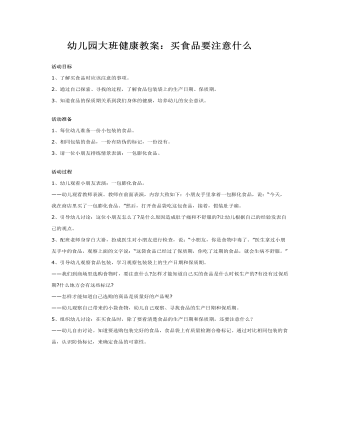
幼儿园大班健康教案:买食品要注意什么
活动准备 1、每位幼儿准备一份小包装的食品。 2、相同包装的食品,一份有防伪的标记,一份没有。 3、请一位小朋友排练情景表演:一包膨化食品。 活动过程 1、幼儿观看小朋友表演:一包膨化食品。 ——幼儿观看教师表演。教师在前面表演,内容大致如下:小朋友手里拿着一包膨化食品,说:“今天,我在商店里买了一包膨化食品。”然后,打开食品袋吃这包食品,接着,假装肚子痛。 2、引导幼儿讨论:这位小朋友怎么了?是什么原因造成肚子痛和不舒服的?让幼儿根据自己的经验发表自己的观点。 3、配班老师身穿白大褂,扮成医生对小朋友进行检查,说:“小朋友,你是食物中毒了。”医生拿过小朋友手中的食品,观察上面的文字说:“这袋食品已经过了保质期,你吃了过期的食品,就会生病不舒服。”
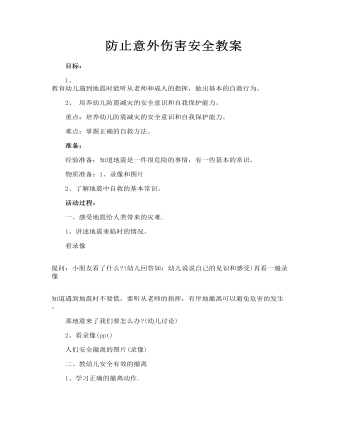
意外伤害安全教案 防止意外伤害安全教案
一、感受地震给人类带来的灾难. 1、讲述地震来临时的情况。 看录像 提问:小朋友看了什么?(幼儿回答如:幼儿说说自己的见识和感受)再看一遍录像 知道遇到地震时不要慌,要听从老师的指挥,有序地撤离可以避免危害的发生。 那地震来了我们要怎么办?(幼儿讨论)
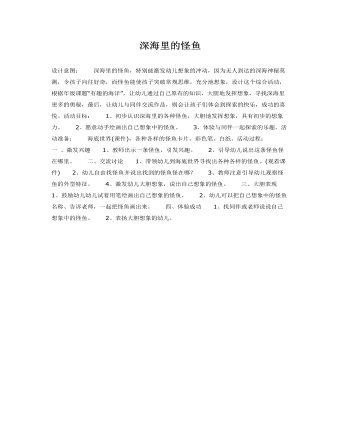
中班综合教育活动教案深海怪鱼
1、初步认识深海里的各种怪鱼,大胆地发挥想象,具有初步的想象力。 2、愿意动手绘画出自己想象中的怪鱼。 3、体验与同伴一起探索的乐趣。活动准备: 海底世界(课件),各种各样的怪鱼卡片,彩色笔、白纸。活动过程: 一、激发兴趣 1、教师出示一条怪鱼,引发兴趣。 2、引导幼儿说出这条怪鱼怪在哪里。 二、交流讨论 1、带领幼儿到海底世界寻找出各种各样的怪鱼。(观看课件)2、幼儿自由找怪鱼并说出找到的怪鱼怪在哪? 3、教师注意引导幼儿观察怪鱼的外型特征。
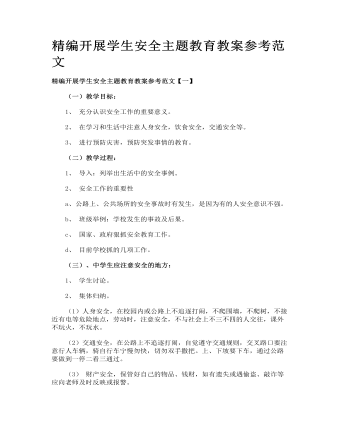
精编开展学生安全主题教育教案参考范文
交通安全 1. 行走时怎样注意交通安全 1)在道路上行走,要走人行道,没有人行道的道路,要靠路边行走。 2)集体外出时,要有组织、有秩序地列队行走。 3)在没有交通民警指挥的路段,要学会避让机动车辆,不与机动车辆争道抢行。 4)穿越马路时,要遵守交通规则,做到“绿灯行,红灯停”。 2. 交通安全 :全国平均每天发生交通事故 1600 起, 死亡 257 人 , 受伤 1147 人 , 直接经济损失 731 万。真是令人痛心。提醒学生们要特别注意交通安全,上放学时一定要遵守交通规则,过马路时要提高警惕,注意来往的车辆。及时消除交通隐患。

部编版语文八年级上册《梦回繁华》教案
2.读了本文,关于《清明上河图》你又有了哪些新的了解?明确:①我了解到了北宋时期,城市繁荣,文化生活十分活跃,《清明上河图》便是反映这一时期城乡市井平民生活的一幅风俗画。②我了解到了画的作者张择端主要活动时期、籍贯、字、生平、爱好等。③我了解到了关于这幅图的画卷大小,描绘的具体内容,特点及价值等。目标导学二:分析说明方法,把握说明顺序1.课文都使用了哪些说明方法?有何作用?明确:(1)列数字:“张择端画的《清明上河图》,绢本,设色,纵24.8厘米,横528.7厘米。”使用准确的数字,说明了《清明上河图》的大小。(2)打比方:“整个长卷犹如一部乐章,由慢板、柔板,逐渐进入快板、紧板,转而进入尾声,留下无尽的回味。”把《清明上河图》比作“一部乐章”,说明它宏大、优美而富有变化的特点。
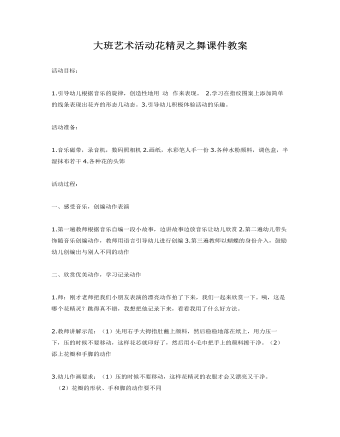
大班艺术活动花精灵之舞课件教案
2.学习在指纹图案上添加简单的线条表现出花卉的形态几动态。3.引导幼儿积极体验活动的乐趣。活动准备:1.音乐磁带,录音机,数码照相机2.画纸,水彩笔人手一份3.各种水粉颜料,调色盒,半湿抹布若干4.各种花的头饰活动过程:一、感受音乐,创编动作表演1.第一遍教师根据音乐自编一段小故事,边讲故事边放音乐让幼儿欣赏2.第二遍幼儿带头饰随音乐创编动作,教师用语言引导幼儿进行创编3.第三遍教师以蝴蝶的身份介入,鼓励幼儿创编出与别人不同的动作

《传承优秀传统文化》主题班会教案3篇
活动要求:1、 各班级务必要邀请一位老师(辅导员或导师),若导生在校,则可邀请导生到场观看。2、 各班级要根据自身情况,由班长、学委负责组织,深入把握该次主题活动精神所在,拟定好方案。并且务必在举行主题班会前提前知会秘书处和学习部的系负责人,及时通知他们主题班会开展的时间地点。3、 各班级的班干部要积极参与主题班会的各项组织工作,做好考勤、场地、议程安排和讨论记录等工作。4、 活动过程注意时间,纪律等方面的控制。推荐活动时间为60分钟。5活动2天内,请各位班长将此计划书与总结书以电子版形式发到秘书处系负责人处.逾期不候.总结书的要求(400字以上):总结内容包括:总结本次主题班会的优缺点、以及工作建议等等。总结是主题班会的成果体现,请班级给予充分重视。班长签名:班会结束后2天内,请各位班长将此计划书与总结书以电子版形式发到秘书处系负责人处.逾期不候.
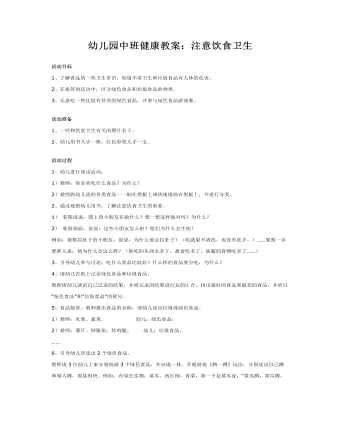
幼儿园中班健康教案:注意饮食卫生
2、在抢答的活动中,区分绿色食品和垃圾食品的种类。 3、乐意吃一些比较有营养的绿色食品,并参与绿色食品游戏赛。活动准备 1、一些和饮食卫生有关的图片若干。 2、幼儿用书人手一册,红色彩笔人手一支。活动过程1、幼儿进行谈话活动: 1)教师:你喜欢吃什么食品?为什么? 2)教师将幼儿说的各类食品一一贴在黑板上或快速地画在黑板上,并进行分类。 2、通过观察幼儿用书,了解注意饮食卫生的重要。 1)看图说说:图上的小朋友在做什么?想一想这样做对吗?为什么?

